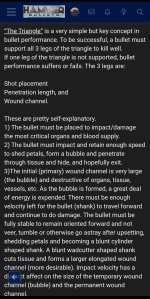Airedale56
Active member
why wouldn’t a hunter just always select/shoot the smallest legal caliber/lightest bullet weight for big game animals?
Assuming vital organ strikes on a calm animal, broadside, there are two holes, in and out, leaking blood, critter exsanguinates and dies.
Hunter recovers dead critter.
Does bullet weight/energy matter if a lot or even most of it is expended on the far side of an animal?
Maybe a better way to inquire is: If both perforate (two holes) a deer, is a deer more dead with a .243 Winchester 70 grain HH vs a .338-06 A-Square 175 HH?
I’m no mathematician, energy figures and theories hurt my head.
I’m a predator hunter Major, Big game hunter Minor.
I have only recovered 2 solid copper bullets from two big game animals, one an elk (.340 Weatherby 225 TSX 1998) and the other a mule deer (.25-06 Remington 115 TSX 2006). Both animals died, first ran and required a finishing shot (!), second collapsed.
I’m in search of education from real world users of the HH on the why of two vs one hole desirability when selecting a Hammer Hunter bullet. Or can one even be stopped and contained on a broadside shot?
From extensive reading here on Hammertime it seems few HH bullets are recovered post-mortem. They definitely kill critters!
I’m looking forward to the reasoning of folks far more experienced than I with the Hammer Hunter bullets.
Specifically in .224/.243/.257/.264/.308/.338 calibers.
Thanks for reading.
Assuming vital organ strikes on a calm animal, broadside, there are two holes, in and out, leaking blood, critter exsanguinates and dies.
Hunter recovers dead critter.
Does bullet weight/energy matter if a lot or even most of it is expended on the far side of an animal?
Maybe a better way to inquire is: If both perforate (two holes) a deer, is a deer more dead with a .243 Winchester 70 grain HH vs a .338-06 A-Square 175 HH?
I’m no mathematician, energy figures and theories hurt my head.
I’m a predator hunter Major, Big game hunter Minor.
I have only recovered 2 solid copper bullets from two big game animals, one an elk (.340 Weatherby 225 TSX 1998) and the other a mule deer (.25-06 Remington 115 TSX 2006). Both animals died, first ran and required a finishing shot (!), second collapsed.
I’m in search of education from real world users of the HH on the why of two vs one hole desirability when selecting a Hammer Hunter bullet. Or can one even be stopped and contained on a broadside shot?
From extensive reading here on Hammertime it seems few HH bullets are recovered post-mortem. They definitely kill critters!
I’m looking forward to the reasoning of folks far more experienced than I with the Hammer Hunter bullets.
Specifically in .224/.243/.257/.264/.308/.338 calibers.
Thanks for reading.
Last edited:

